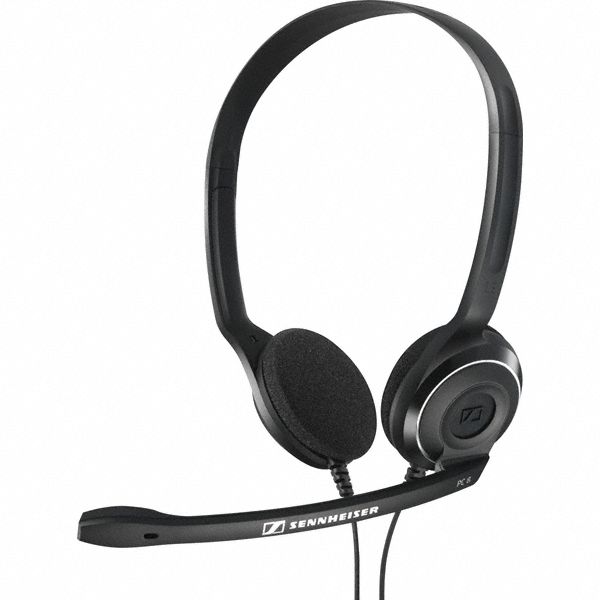This is a review of the Sennheiser PC–8 digital mic/headset with 48 kHz sampling. Ahead you will hear my test recordings, both flat and with Hindenburg’s one-click Voice Profiler equalization, against another microphone recorded simultaneously. You’ll also learn about how to set the Sennheiser PC–8’s built-in A-D (Analog-to-Digital converter) via software for 48 kHz, which is a feature that the manufacture apparently has not documented yet but indeed exists.

This is a review of the Sennheiser PC–8 digital mic/headset with 48 kHz sampling. Ahead you will hear my test recordings, both flat and with Hindenburg’s one-click Voice Profiler equalization, against another microphone recorded simultaneously. You’ll also learn about how to set the Sennheiser PC–8’s built-in A-D (Analog-to-Digital converter) via software for 48 kHz, which is a feature that the manufacture apparently has not documented yet but indeed exists.
In this article
- Sidebar: What do we mean by a digital microphone?
- Unlike the Plantronics .Audio 326 headset…
- Specifications, per the manufacturer
- General virtues of head mounted microphones
- How do I select the desired sampling frequency between 44.1 kHz and 48 kHz?
- Comparison recordings made simultaneously
- How I made the simultaneous test recordings
- Sennheiser PC–8 SCM rating
- Surprising conclusions
- Related recent articles
- Related upcoming articles
What do we mean by a digital microphone?
When we say a digital microphone, we mean that it has a built-in preamplifier, A-to-D (analog-to-digital) converter, and a digital output. We don’t mean that the actual microphone element is digital (which it is not), just as when we talk about a digital speaker, we don’t mean that the cone is digital… or when we talk about a USB printer, we don’t mean that the actual print head is USB.
Unlike the Plantronics .Audio 326 headset…
Unlike the Plantronics .Audio 326 headset (shown above) which I reviewed in September 2014 (whose only connections are analog), the Sennheiser PC–8’s only connection is digital. To be more specific, the Sennheiser PC–8 contains its own preamp and A-to-D (analog-to-digital) converters and terminates in a standard-A USB plug. This means that the preamp and A-to-D in the computer or tablet is completely bypassed. Although I did most of my testing of the Sennheiser PC–8 on my MacBook Air using Hindenburg Journalist PRO (which I covered in two recent articles, Meet the Hindenburg family of audio production/editing tools and Why Hindenburg Journalist PRO is the best Skype audio production tool I’ve ever used), I also tested the Sennheiser PC–8 headset very briefly with an iPad Air 2 and an iPhone 5 that friends own, using Apple’s female USB-to-Lightning adapter, where the Sennheiser PC–8 also worked as expected.
Specifications, per the manufacturer
General
Wearing style: Headband
Connector: USB
Cable length: 2 meters
Weight: 84 grams
Controls: In-line volume for headphones/mute control for microphone
2-year warranty
Stereo headphones
Frequency response (headphones) 42 – 17000 Hz
Sound pressure level (SPL) 95 dB
Ear coupling on-the-ear, open design
Transducer principle: dynamic, closed
Microphone
Frequency response: 90–15000 Hz
Pick-up pattern: uni-directional
General virtues of head mounted microphones
Head mounted microphones have specific virtues, including isolation, consistent distance between mouth and element, elimination of the cost & complexity of mounting gear, and —in some cases (including the Sennheiser PC-8)— built-in listening devices. Consistency of the distance between a microphone and the speaker’s voice is critical for consistent sound. With a head mounted microphone, it is very easy to lock in the sweet spot between plosives/excessive breathing… and sounding off mic. The person speaking can even alternate from reclining or sitting up straight without affecting the distance. Although this is possible with handheld or microphones mounted somewhere other than the speaker’s body, it requires a conscious and continuous effort on the part of the person speaking not to allow the distance to change during a program, even if it means moving a flexible arm when the microphone is suspended in a shock-absorbing mount. Of course, this can be a tradeoff between the highest quality at the ideal distance with a different mic and a potential price of convenience. Let’s see how good —or bad— the Sennheiser PC–8 sounds versus our my standard studio mic.
How do I select the desired sampling frequency between 44.1 kHz and 48 kHz?
It is actually much simpler to select the desired sampling frequency from a digital microphone (or A-to-D converter) on iOS (iPad/iPhone/iPod Touch) than on a Mac. On iOS, you have to select it in a single place, in the recording app, if available (as it fortunately is in RØDE Rec, FilMiC Pro), and ShurePlus MOTIV. On a Mac, you must select it in two different places with most software I have used: first in the Audio Midi Setup (which is currently located in the Utility folder in modern Macs), and then in the recording app itself. If it is set differently in each place, you will get undesired results, so remember to switch it in both places. I really don’t know where it is switched in the Windows operating system. I set the A-to-D converter in both microphones used in this test to 48 kHz to match the standard for audio for digital video.
Comparison recordings made simultaneously
Ahead you can listen to comparative simultaneous recordings between the Sennheiser PC–8 compared with the Audio Technica AT2005USB (covered in several past articles and ebooks) mounted on a Heil PL–2T flexible arm. You can hear each one either flat or equalized with Hindenburg Journalist PRO Voice Profiler.
How I made the simultaneous test recordings
I connected each tested microphone to a different USB port on my MacBook Air and recorded them on independent tracks at 48 kHz using Hindenburg Journalist Pro’s multitrack feature. There I trimmed the tracks together and leveled each independently. Each track was exported independently as an uncompressed mono 48 kHz at –16 LUFS (See my Meet the Hindenburg family of audio production/editing tools article for information about LUFS loudness) and uploaded into SoundCloud. SoundCloud automatically created a corresponding MP3 for streaming via the player, but you are also welcome to download the original uncompressed WAV file if desired. I actually exported and uploaded two: one flat, and the other with Hindenburg Journalist PRO’s Voice Profiler EQ, so you can listen to both.
Sennheiser PC–8 SCM rating
You may recall the SCM scale from my recent article called Establishing SCM: a standard Scale for Confidence Monitoring, illustrated above.
The Sennheiser PC–8 by itself achieves zero (0) SCM rating, since its inboard headphones offer no latency-free monitoring on its own merit, and can only monitor what is sent from the computer, tablet or telephone. When used with a program like Hindenburg Journalist PRO (which offers both onscreen level indication and the option to turn on live audio monitoring on a per-source basis, although with latency), the Sennheiser PC–8 can achieve a systematic SCM rating of 75. For more information about the SCM scale, see the original article.
Surprising conclusions
Unlike the prior experience I have had with the Hindenburg Voice Profiler (which is an automatic intelligent EQ) with the AT2005USB, where the difference is relatively subtle, with the Sennheiser PC-8, the difference is enormous, because the AT2005USB naturally produces a desirable voice sound without requiring much equalization. In my opinion, the flat recordings made with the Sennheiser PC–8 are just okay, but not very nice sounding. After the Hindenburg Voice Profiler, the improvement is very noticeable and in a very positive way. From a professional video perspective, it’s almost as if the raw audio from the Sennheiser PC–8 were analogous to RAW video like ARRI Alexa RAW, CinemaDNG RAW, RED One/EPIC/Scarlet/Dragon R3D files or Sony S-log: pre-emphasized for greater latitude when “grading”/equalization. Any reader of this article who is a grader, etalonador or etalonadora is welcome to comment whether you agree with the analogy (or not) after hearing the flat Sennheiser PC–8 recording versus one processed with the Hindenburg Voice Profiler.
The Sennheiser PC–8 is extremely compact and practical. The raw sound of its built-in microphone raw sound is intelligible, but far from wonderful. After being processed by the Hindenburg Voice Profiler, the sound becomes surprisingly much more pleasing to me, although not quite as good as the raw sound from the AT2005USB. In my observation, the Sennheiser PC–8 was surprisingly resistant to plosives, although it is a bit more sensitive to human breathing than the AT2005USB. However, it is quite practical for portable use in those cases when you can’t carry the AT2005USB, a support device, and headphones.
Recent related articles
- Review: Plantronics accidentally enters broadcast headset market
- Establishing SCM: a standard Scale for Confidence Monitoring
- Meet the Hindenburg family of audio production/editing tools
- Why Hindenburg Journalist PRO is the best Skype audio production tool I’ve ever used
Upcoming related articles
- Review: Audio Technica BP40 high-end dynamic studio microphone
- A return to multitrack USB audio on Mac, with catches
- My audio confession
- The ascension of audiobooks to the next level of glory
Upcoming articles, reviews, and books
Stand by for upcoming articles, reviews, and books. Sign up to my free mailing list by clicking here.
Si deseas suscribirte a mi lista en castellano, visita aquí. Si prefieres, puedes suscribirte a ambas listas (castellano e inglés).
Books, consulting, articles, seminars & audio programs
Contact Allan Tépper for consulting, or find a full listing of his books, articles and upcoming seminars and webinars at AllanTepper.com. Listen to his CapicúaFM program at CapicúaFM.com in iTunes or Stitcher.
My latest book (paperback + ebook)
My most recent book is available in two languages, and in paperback as well as an ebook. The ebook format is Kindle, but even if you don’t have a Kindle device, you can read Kindle books on many other devices using a free Kindle app. That includes iPad, Android tablets, Mac computers, and Windows computers. Although generally speaking, Kindle books are readable on smartphones like Androids and iPhones, I don’t recommend it for this particular book since it contains both color photos and color comparison charts. The ebook is also DRM-free.
In English, it’s The Castilian Conspiracy. Click here and you will be automatically sent to the closest Amazon book page to you based upon your IP address. Or request ISBN–10: 1456310232 or ISBN–13: 978–1456310233 in your favorite local bookstore.
En castellano, se llama La conspiración del castellano. Haz clic aquí para llegar al instante a la página del libro correspondiente a tu zona y moneda en Amazon, según tu dirección IP. De lo contrario, solicítalo en tu librería preferida con los ISBN–10: 1492783390 ó el ISBN–13: 978–1492783398.
FTC disclosure
No manufacturer is specifically paying Allan Tépper or TecnoTur LLC to write this article or the mentioned books. Some of the other manufacturers listed above have contracted Tépper and/or TecnoTur LLC to carry out consulting and/or translations/localizations/transcreations. Many of the manufacturers listed above have sent Allan Tépper review units. So far, none of the manufacturers listed above is/are sponsors of the TecnoTur programs, although they are welcome to do so, and some are, may be (or may have been) sponsors of ProVideo Coalition magazine. Some links to third parties listed in this article and/or on this web page may indirectly benefit TecnoTur LLC via affiliate programs.
Copyright and use of this article
The articles contained in the TecnoTur channel in ProVideo Coalition magazine are copyright Allan Tépper/TecnoTur LLC, except where otherwise attributed. Unauthorized use is prohibited without prior approval, except for short quotes which link back to this page, which are encouraged!


